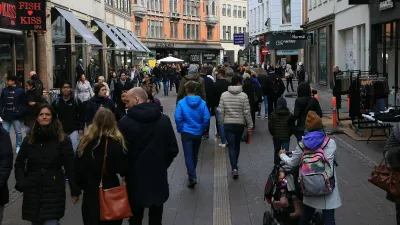Many streets and cities are designed for vehicles instead of for pedestrians. But policies and programs in cities around the world, and even in the United States, might be signaling a shift in priorities.

Richard Conniff takes a look at recent efforts to make cities better places for pedestrians. In Europe, car restrictions and bans are planned or have been instituted in Oslo, Madrid, and Paris, even in the face of public opposition, he says:
Yes, car owners are furious. That's because they have mistaken their century-long domination over pedestrians for a right rather than a privilege. The truth is that cities are not doing nearly enough to restore streets for pedestrian use, and it's the pedestrians who should be furious.
In the United States, the notion that streets are for cars is exemplified by level of service standards based on vehicle throughputs. The result is increased air pollution, more expensive cities, and streetscapes that are not conducive to more sustainable modes of travel. "Urban walking has thus deteriorated from a civilized pleasure to an overheated, unshaded, traffic-harried race to a destination," laments Conniff.
Still, he points to examples of change happening at the grassroots level, including the Walk [Your City] program, which promotes wayfinding and walkability, and the Better Block Foundation, an organization that helps communities with placemaking and neighborhood development projects.
"In many of the major cities of the world, it has begun to dawn even on public officials that walking is a highly efficient means of transit, as well as one of the great underrated pleasures in life," says Conniff.
FULL STORY: The Pedestrian Strikes Back

National Parks Layoffs Will Cause Communities to Lose Billions
Thousands of essential park workers were laid off this week, just before the busy spring break season.

Retro-silient?: America’s First “Eco-burb,” The Woodlands Turns 50
A master-planned community north of Houston offers lessons on green infrastructure and resilient design, but falls short of its founder’s lofty affordability and walkability goals.

Delivering for America Plan Will Downgrade Mail Service in at Least 49.5 Percent of Zip Codes
Republican and Democrat lawmakers criticize the plan for its disproportionate negative impact on rural communities.

Test News Post 1
This is a summary

Test News Headline 46
Test for the image on the front page.

Balancing Bombs and Butterflies: How the National Guard Protects a Rare Species
The National Guard at Fort Indiantown Gap uses GIS technology and land management strategies to balance military training with conservation efforts, ensuring the survival of the rare eastern regal fritillary butterfly.
Urban Design for Planners 1: Software Tools
This six-course series explores essential urban design concepts using open source software and equips planners with the tools they need to participate fully in the urban design process.
Planning for Universal Design
Learn the tools for implementing Universal Design in planning regulations.
EMC Planning Group, Inc.
Planetizen
Planetizen
Mpact (formerly Rail~Volution)
Great Falls Development Authority, Inc.
HUDs Office of Policy Development and Research
NYU Wagner Graduate School of Public Service




























